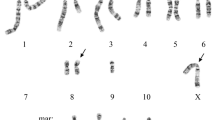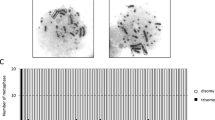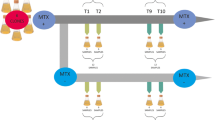Abstract
The CHO cell line was mutagenized with radiation and by chemical treatment, and a CHO DG44 mutant carrying a double deletion for the dihydrofolate reductase gene located on chromosome 2 was isolated and characterized. Among the different sublines, CHO DG44 cells are widely used for the stable production recombinant proteins since they exhibit the DHFR-selection and amplification system. To our knowledge, the karyotype of CHO-DG44 cells has not been studied. After analysis of more than 100 metaphases, we consistently found 20 chromosomes whereas the normal diploid Chinese hamster genome was characterized with 22 chromosomes. The quasi-diploid CHO DG44 cells were found to have a karyotype altered from the original Chinese hamster. Only seven of the chromosomes were normal including the two chromosomes 1, one chromosome 2, 4, 5, 8 and 9. The four chromosomes Z1, Z4, Z8 and Z13 were identified as described by Deaven and Peterson (Deaven and Petersen 1973). The remaining chromosomes were 7 derivative chromosomes (rearrangement within a single chromosome or involving two or more chromosomes) and 2 marker chromosomes (structurally abnormal chromosome in which no part can be identified). We believe that insights from these studies can be of value for a genetic characterization of CHO DG44 cells expressing a recombinant protein as well as for work on targeted or homologous integration into the genome.
Preview
Unable to display preview. Download preview PDF.
Similar content being viewed by others
References
Deaven LL, Petersen DF. 1973. The chromosomes of CHO, an aneuploid Chinese hamster cell line: G-band, C-band, and autoradiographic analyses. Chromosoma 41(2): 129–44.
ISCN. 1995. An International System for Human Cytogenetic Nomenclature. Mitelman F, editor: Karger.
Kaufman R.J., Wasley L.C., Spiliotes A.J., Gossels SD, Latt S.A., Larse GR, M. KR. 1985. Coamplification and coexpression of human tissue-type plasminogen activator and murine dihydrofolate reductase sequences in chinese hasmter ovary cells. Molecular and Cellular Biology 5(7): 1750–1759.
Ray M, Mohandas T. 1976. Proposed banding nomenclature for the Chinese hamster chromosomes (Cricetulus griseus). Cytogenet Cell Genet 16(1–5): 83–91.
Urlaub G, Chasin LA. 1980. Isolation of Chinese hamster cell mutants deficient in dihydrofolate reductase activity. Proc Natl Acad Sci U S A 77(7): 4216–20.
Urlaub G, Kas E, Carothers AM, Chasin LA. 1983. Deletion of the diploid dihydrofolate reductase locus from cultured mammalian cells. Cell 33: 405–412.
Author information
Authors and Affiliations
Editor information
Editors and Affiliations
Rights and permissions
Copyright information
© 2007 Springer
About this paper
Cite this paper
Martinet, D., Derouazi, M., Besuchet, N., Wicht, M., Beckmann, J., Wurm, F. (2007). Karyotype of CHO DG44 cells. In: Smith, R. (eds) Cell Technology for Cell Products., vol 3. Springer, Dordrecht. https://doi.org/10.1007/978-1-4020-5476-1_59
Download citation
DOI: https://doi.org/10.1007/978-1-4020-5476-1_59
Publisher Name: Springer, Dordrecht
Print ISBN: 978-1-4020-5475-4
Online ISBN: 978-1-4020-5476-1
eBook Packages: Chemistry and Materials ScienceChemistry and Material Science (R0)




